
Eure is a department in Normandy in Northwestern France, named after the river Eure. Its prefecture is Évreux. In 2021, Eure had a population of 598,934.

Bayeux is a commune in the Calvados department in Normandy in northwestern France.
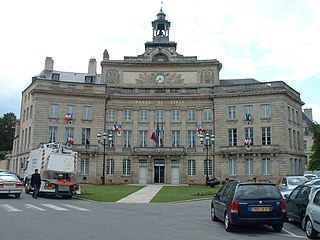
Alençon is a commune in Normandy, France, and the capital of the Orne department. It is situated 173 kilometres (107 mi) west of Paris. Alençon belongs to the intercommunality of Alençon.
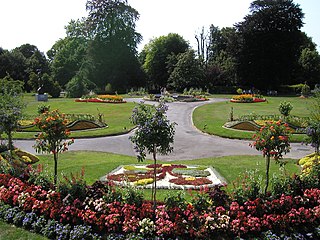
Avranches is a commune in the Manche department, and the region of Normandy, northwestern France. It is a subprefecture of the department. The inhabitants are called Avranchinais.

Mont-Saint-Aignan is a commune in the Seine-Maritime department in the region of Normandy, northwestern France.

Les Andelys is a commune in the northern French department of Eure, in Normandy.

Château Gaillard is a medieval castle ruin overlooking the River Seine above the commune of Les Andelys, in the French department of Eure, in Normandy. It is located some 95 kilometres (59 mi) north-west of Paris and 40 kilometres (25 mi) from Rouen. Construction began in 1196 under the auspices of Richard the Lionheart, who was simultaneously King of England and feudal Duke of Normandy. The castle was expensive to build, but the majority of the work was done in an unusually short period of time. It took just two years and, at the same time, the town of Petit Andely was constructed. Château Gaillard has a complex and advanced design, and uses early principles of concentric fortification; it was also one of the earliest European castles to use machicolations. The castle consists of three enclosures separated by dry moats, with a keep in the inner enclosure.

Verneuil-sur-Avre is a former commune in the Eure department in Normandy in northern France. On 1 January 2017, it was merged into the new commune Verneuil d'Avre et d'Iton.

Rouen Cathedral is a Catholic church in Rouen, Normandy, France. It is the see of the Archbishop of Rouen, Primate of Normandy. It is famous for its three towers, each in a different style. The cathedral, built and rebuilt over a period of more than eight hundred years, has features from Early Gothic to late Flamboyant and Renaissance architecture. It also has a place in art history as the subject of a series of impressionist paintings by Claude Monet, and in architecture history as from 1876 to 1880, it was the tallest building in the world.

Flamboyant is a form of late Gothic architecture that developed in Europe in the Late Middle Ages and Renaissance, from around 1375 to the mid-16th century. In the French timetable of styles, as defined by French scholars, it is the fourth phase of Gothic style, preceded by Primary Gothic, Classic Gothic and Rayonnant Gothic.

Bernay is a commune in the west of the Eure department in Northern France.

Gaillon is a commune in the Eure department in northern France.

Ouche Abbey or the Abbey of Saint-Evroul is a former Benedictine abbey in Normandy, located in the present commune of Saint-Évroult-Notre-Dame-du-Bois, Orne, Normandy. It has been classified as a Monument historique since 1967 and is designated "classé".

Bihorel is a commune of the Seine-Maritime department in the Normandy region in northern France. It is a northeastern suburb of Rouen.

Liesse-Notre-Dame is a commune in the Aisne department in Hauts-de-France in northern France. In the Middle Ages, the village near Laon developed around the cult of the Black Virgin, known as Notre-Dame de Liesse. Pope Pius IX granted the Marian image a decree of canonical coronation on 18 August 1857.
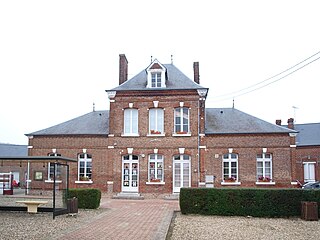
Vieux-Rouen-sur-Bresle is a French commune in the Seine-Maritime department in the Normandy region in northern France.

La Ferté Macé is a commune in the Orne department, region of Normandy, northwestern France.
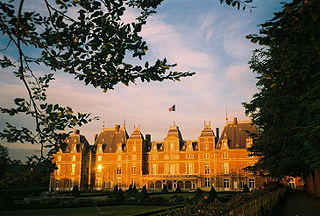
Eu is a commune in the Seine-Maritime department in the Normandy region in northern France.

The Church of Notre-Dame de Louviers is a parish church located in Louviers, a town in the Eure department. It is a notable example of Gothic church architecture in northern France. The north façade, and, especially the south façade and porch, are some of the best examples of late Flamboyant Gothic architecture in France.
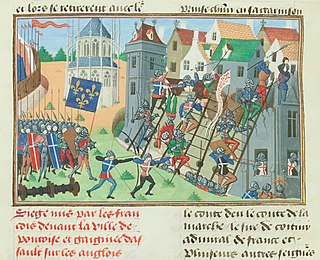
The siege of Pontoise took place during the Hundred Years War. French forces led by King Charles VII of France besieged and captured the last English stronghold in Île de France, eliminating the English threat to Paris.

























